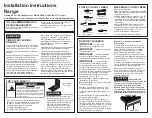
14
ROASTING
Do not lock the oven door with the latch during
roasting. The latch is used for self-cleaning only.
Roasting is cooking by dry heat. Tender meat or
poultry can be roasted uncovered in your oven.
Roasting temperatures, which should be low and
steady, keep spattering to a minimum.
Roasting is really a baking procedure used for meats.
Roasting is easy; just follow these directions:
Most meats continue to cook slightly while standing,
after being removed from the oven. The standing time
recommended for roasts is 10 to 20 minutes. This
allows roasts to firm up and makes them easier to
carve. The internal temperature will rise about 5° to
10°F.; to compensate for temperature rise, if desired,
remove the roast from the oven sooner (at 5° to 10°F.
less than the temperature in the Roasting Guide).
Remember that food will continue to cook in the hot
oven and therefore should be removed when the
desired internal temperature has been reached.
1. Place the shelf in A or B position. No preheating
is necessary.
2. Check the weight
of the meat. Place
it, fat side up, (or
for poultry, breast-
side-up) on the
roasting rack in a
shallow pan. The
melting fat will
baste the meat. Select a pan as close to the size of
the meat as possible. (The broiler pan with rack
is a good pan for this.) Line the broiler pan with
aluminum foil when using the pan for marinating,
cooking with fruits, cooking heavily cured meats or
basting food during cooking. Avoid spilling these
materials inside the oven or inside the oven door.
3. Turn the Oven Temperature knob to the desired
setting.
4. After roasting is complete, turn the Oven
Temperature knob to OFF and then remove the
food from the oven.
B
A
Use of Aluminum Foil
You can use aluminum foil to line the broiler pan.
This makes clean-up easier when using the pan for
marinating, cooking with fruits, cooking heavily
cured meats or basting food during cooking. Press
the foil tightly around the inside of the pan.














































